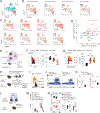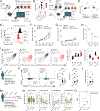LAG-3 sustains TOX expression and regulates the CD94/NKG2-Qa-1b axis to govern exhausted CD8 T cell NK receptor expression and cytotoxicity
- PMID: 39121847
- PMCID: PMC11337978
- DOI: 10.1016/j.cell.2024.07.018
LAG-3 sustains TOX expression and regulates the CD94/NKG2-Qa-1b axis to govern exhausted CD8 T cell NK receptor expression and cytotoxicity
Abstract
Exhausted CD8 T (Tex) cells in chronic viral infection and cancer have sustained co-expression of inhibitory receptors (IRs). Tex cells can be reinvigorated by blocking IRs, such as PD-1, but synergistic reinvigoration and enhanced disease control can be achieved by co-targeting multiple IRs including PD-1 and LAG-3. To dissect the molecular changes intrinsic when these IR pathways are disrupted, we investigated the impact of loss of PD-1 and/or LAG-3 on Tex cells during chronic infection. These analyses revealed distinct roles of PD-1 and LAG-3 in regulating Tex cell proliferation and effector functions, respectively. Moreover, these studies identified an essential role for LAG-3 in sustaining TOX and Tex cell durability as well as a LAG-3-dependent circuit that generated a CD94/NKG2+ subset of Tex cells with enhanced cytotoxicity mediated by recognition of the stress ligand Qa-1b, with similar observations in humans. These analyses disentangle the non-redundant mechanisms of PD-1 and LAG-3 and their synergy in regulating Tex cells.
Keywords: CD94; LAG-3; NKG2; NKG2A; PD-1; Qa-1b; T cell exhaustion; TOX; cancer; immunosurveillance.
Copyright © 2024 Elsevier Inc. All rights reserved.
Conflict of interest statement
Declaration of interests E.J.W. is a member of the Parker Institute for Cancer Immunotherapy which supported this study. E.J.W. is an advisor for Arsenal Bioscience, Coherus, Danger Bio, Janssen, New Limit, Marengo, Pluto Immunotherapeutics, Prox Biosciences, Related Sciences, Santa Ana Bio, and Synthekine. E.J.W. is a founder of and holds stock in Arsenal Biosciences. A.H.S. has patents/pending royalties on the PD-1 pathway from Roche and Novartis and has research funding from IOME, AbbVie, and Taiwan Bio. A.H.S. serves as an advisor for Selecta, Elpiscience, Monopteros, Bicara, Fibrogen, IOME, Bioentre, Corner Therapeutics, Alixia, GlaxoSmithKline, Amgen, and Janssen. D.A.A.V. has patents covering LAG-3, with others pending. D.A.A.V. is a co-founder and stockholder for Novasenta, Tizona, and Trishula; a stockholder for Oncorus and Werewolf; and has patents licensed to Bristol Myers Squibb (BMS) and Novasenta. D.A.A.V. is a scientific advisor for Tizona, Werewolf, F-Star, Bicara, Apeximmune, and T7/Imreg Bio and is a consultant for BMS, Incyte, Regeneron, Ono Pharma, Peptone, and Avidity Partners. D.A.A.V. receives research funding from BMS and Novasenta. O.K. holds stock in Arsenal Biosciences and is an employee of Orange Grove Bio. A.C.H. consults for Immunai and received research funding from BMS and Merck. J.R.G. consults for Arsenal Biosciences.
Figures






References
MeSH terms
Substances
Grants and funding
- P01 CA210944/CA/NCI NIH HHS/United States
- P01 CA236749/CA/NCI NIH HHS/United States
- F30 AI129263/AI/NIAID NIH HHS/United States
- U19 AI117950/AI/NIAID NIH HHS/United States
- T32 CA009140/CA/NCI NIH HHS/United States
- R01 AI155577/AI/NIAID NIH HHS/United States
- U19 AI082630/AI/NIAID NIH HHS/United States
- P50 CA174523/CA/NCI NIH HHS/United States
- R01 AI115712/AI/NIAID NIH HHS/United States
- R01 CA273018/CA/NCI NIH HHS/United States
- P30 CA016520/CA/NCI NIH HHS/United States
- P01 AI108545/AI/NIAID NIH HHS/United States
- P01 AI056299/AI/NIAID NIH HHS/United States
- R01 AI144422/AI/NIAID NIH HHS/United States
LinkOut - more resources
Full Text Sources
Research Materials

